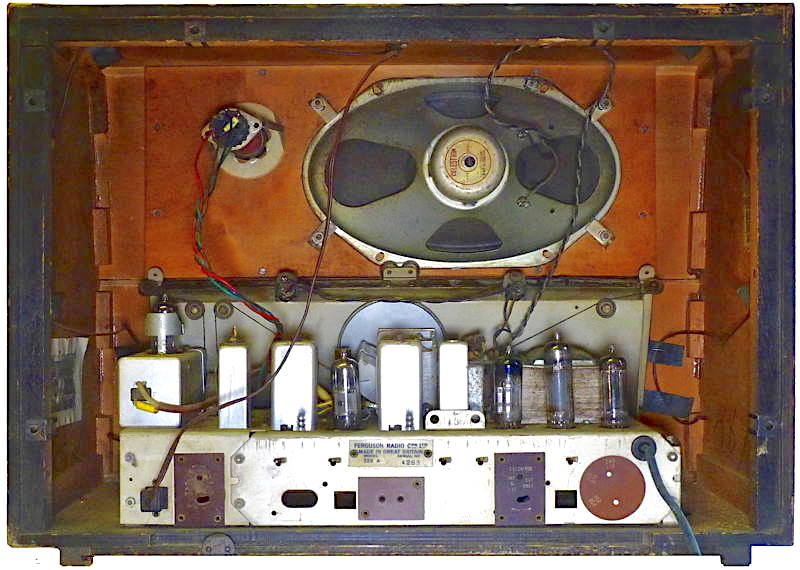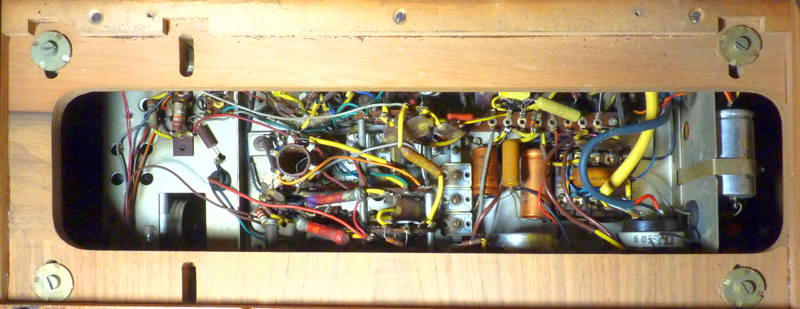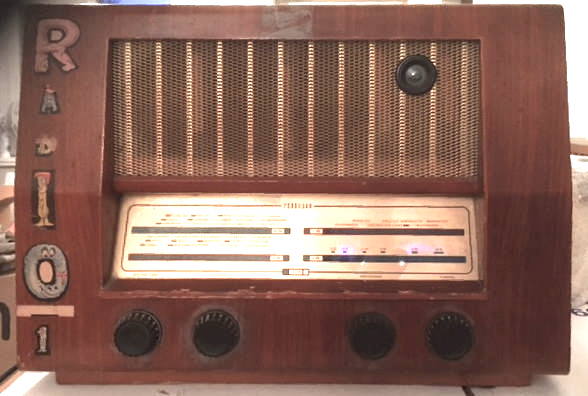Ferguson Radio 329A
serial no 4283

serial no 4283

Ferguson model 329A s/n 6841 This is a five valve plus
rectifier plus tuning indicator superhet table radio housed in a
veneered wood case with
sloping
front. Designed to operate from AC mains 200/250Volts 40-60Hz. Valve
line up ECC85, ECH81, EF85, EABC80, EL84, EZ80 and EM84. It has Long,
Medium,VHF FM and Short wavebands with flywheel tuning, volume and tone
controls.
The price
when first produced in 1955 was £27.0s.7d.(plus purchase tax). Ferguson
was
part of Thorn Electrical Industries. (Ferguson Radio Corporation
founded
in 1923 was taken over by Thorn in 1936)
Ian Wilson had his father's old radio in various lofts over the last 30 odd years and rather than 'dump it' wanted to donate it to someone who might cherish it, or worst case it use it as spares. He found my site online and thought I might be interested in taking it. He attached some photos which gave an idea of condition - the stickers he stuck on when very young didn't help it's look but he thought they would come off OK. He assured me that the wood was sound and not rotten or 'wood wormed' and said that the screws holding back cover were missing but the cover itself was in good condition.
When it arrived it was very dusty and needed a good clean, the labels on the front just needed water, detergent and thumbnail to remove them, but the remains of aged self adhesive packing tape which had been used to keep the rear cover in place proved more difficult to remove, but persevering with white spirit eventually removed them.
The first problem was the wiring to the 3pin plug, it had a 13A fuse, no cable clamp and a loose neutral connection. Having fixed this and fitted a 5A fuse I connected the set to my variable transformer and gradually increased the voltage. I was rewarded with intermittent sound when I attached an external aerial, the wave change control indicated action of sorts on all bands. There was a serious problem with the volume control but restoring the radio now looked promising. it is possible to get limited access to the underside of the chassis by removing a cardboard cover but it was clear that to get at the volume control the whole chassis would have to be removed (4 screws on the underside) I removed the loudspeaker and the magic eye and put the cabinet to one side so that I could get behind the dial glass clean and adjust the waveband flag markers, oil the pulleys and bearings for the tuner flywheel, clean the valves and their contact pins. The tone control which incorporates the double pole mains switch and the volume control both have long shafts which meant that I had to unsolder the wires to the latter so that it could be removed for inspection/repair or replacement. Fortunately I was able to clean the carbon track with switch cleaner and found that it then worked smoothly and could then be put back in place.
One of the capacitors on the underside of the chassis had split open and clearly needed replacement so I supported the set with a temporary wooden support and replaced this and three more. As can be seen the layout out of the original components and the wiring made this quite a trial and I resorted to cutting out the defective ones leaving wire stubs to which loops made in the replacements could be soldered. This work improved the performance of the radio but the magic eye failed to show signs of life.
The expanded aluminium speaker grille was very dirty but responded
to scrubbing with a nail brush in hot water and floor cleaner. I
touched up a number of minor scratches with a brown felt tip marker but
the horizontal section below the dial needed more drastic treatment.
This involved 'Nitromors' paint remover, a scraper and sandpaper
followed by the application of brown watercolour paint and two of
shellac varnish.

Close up view of inside

Not the tidiest wiring!

This is what it looked like when I
received it (complete withteen agers additions!)

